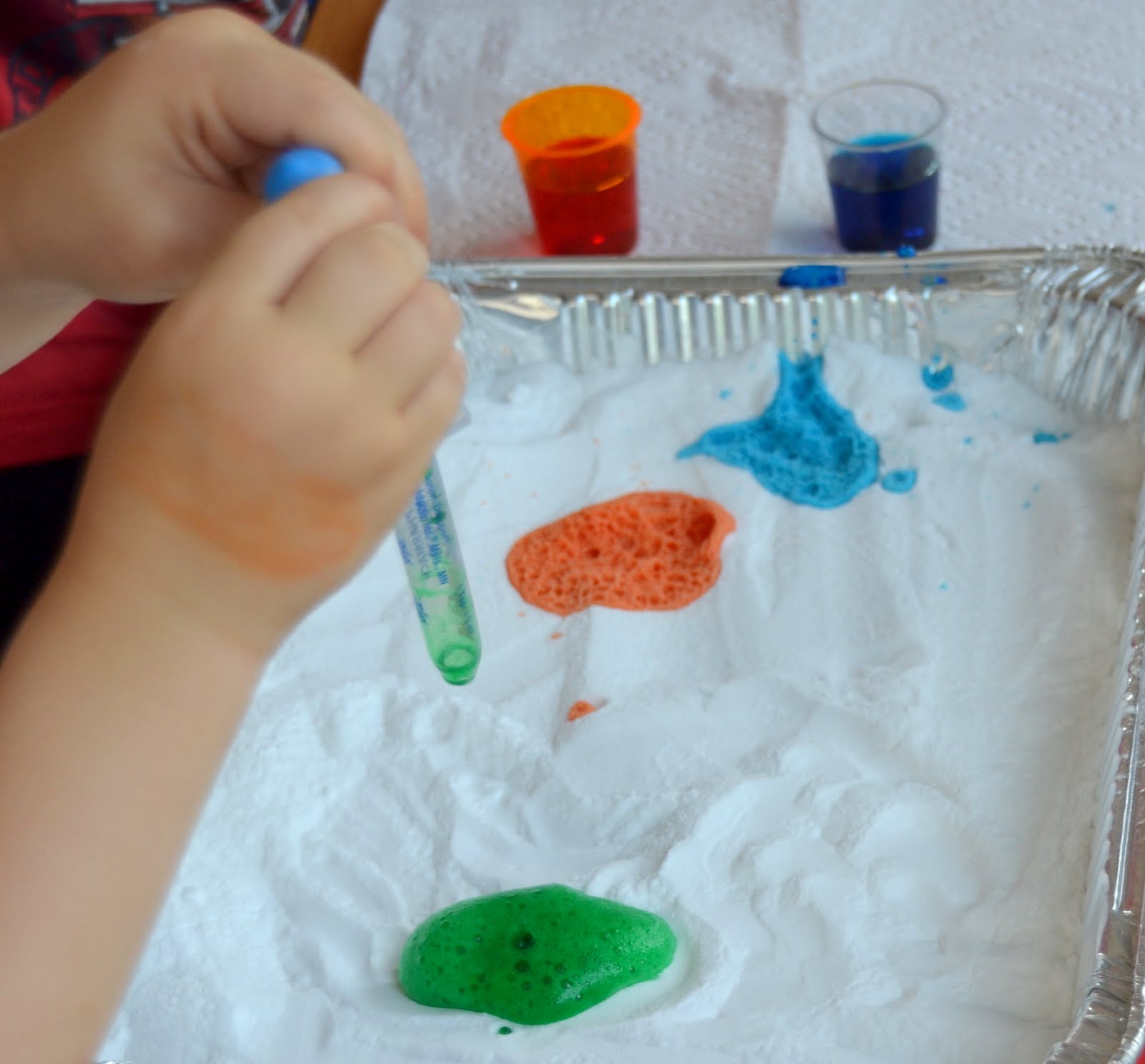What You Will Need
- A large amount of Baking Soda (i.e. think in terms of cups, not teaspoons)
- Vinegar
- Food colouring
- A dish, tray, tub... (I use a disposable roasting dish, but it cleans off perfectly every time with just a quick rinse)
- Small cups/pots to minimise clean-up from spills (I use plastic shot-glasses; mini play-doh pots would be ideal since they are hard to tip over)
- Eye droppers
- Paper towels
- Instructions on how to get food colouring out of clothes (I can vouch for this method with inexact measurements used two hours after the initial stain--it probably helps that vinegar is involved from the start)
So here is our set-up. The first time I ever did this, I just put a thin layer of baking soda down and it was swamped by the amount of vinegar the children deluged it with. These days, I buy my baking soda from a wholesaler and I pour it approx 1cm thick.
I have two children, aged two and four, so they each have their own dropper and their favoured colours on their side. When I refill the cups, they may swap colours. If possible, it would probably be more effective to provide one eye-dropper per colour, since they can be a little careless about emptying the dropper before going to the next colour.
Directions:
Obvious enough...
- Step 1: Fill dropper with coloured vinegar.
- Step 2: Squeeze vinegar over baking soda.
- Step 3: Admire the result.
- Step 4: Repeat until supplies/attention span exhausted.
This really is fantastic to watch. The baking soda looks and feels beautiful to start with anyway, it's so soft and white. The fizzing of the chemical reaction (green in the above photo) is always fun, but when the bubbles subside, we're left with cratered patches of colour (the blue and orange above).
Your child will need to know how to use a dropper--though this is a good way to teach them. (I also recommend giving them a dropper or turkey baster in the water table / bath.) If they've not mastered that skill, expect some confusion and 'misplaced' vinegar.
If you want to get into the science of it, (or even if you don't, but want to be prepared for the inevitable day when your kids ask), there are 'simple' explanations of the baking soda / vinegar reaction here and here. The simplest I can reduce it to for mine is that it's a chemical reaction, which means the baking soda and vinegar are turning each other into other things. One of those things is a gas, and that's what makes the bubbles. That still goes over my four year old's head.
The End Result
I am fairly sure that older, more aesthetically conscious children, could produce a fantastic abstract piece of art with this, a surreal rainbow cratered landscape... What mine generally do is pile all their colours onto one spot making a mushy brown patch, with some squabbling over territory.
Please note that this took about five minutes, and included me refilling the cups once. This isn't really something that's worth the effort of set-up if you're looking to occupy them while you get on with something else. I have debated giving my son a small jug of vinegar and the food colouring so that he can refill their cups as needed (and experiment with mixing colours, if he so desires), but I am wary that my daughter will take matters into her own hands--a staining disaster waiting to happen.
I have managed to extend the game a little though....
Extension Activities
Given the chance, your child might well continue until all the baking soda is a saturated mish-mash of colour. If it's too swampy, this is the time to clean everything up, but otherwise, you've got something rather akin to rainbow sand. New sensory activity ahoy!
It really isn't the best medium, but you can mould it to an extent. My daughter lost interest, but my son spent about ten minutes using the now empty cups to make sandcastles. This does get messy, since once their hands go into the tray, the 'sand' will start coming out of it, and it might be better done out of doors--but I've never had a problem cleaning everything up again. It's baking soda and vinegar after all.
Thanks to the inherent cleansing attributes of the medium, even the smallest tots should be able to help clean up the mess afterwards. My children are expected to carry cups and droppers to the kitchen counter and use the paper towel to wipe up spills. I supply more towels as needed, empty the dish out and rinse everything off again.
Really, I should make the children do the washing up, but I am taking a break from cleaning up the puddles my daughter leaves on the floor.
For further art adventures in the baking soda / vinegar genre, check out this (probably best done outdoors) alternative: Exploding Paint Bags. This sounds amazing, but right now, I am far too much of a coward to actually try it out.




Looks fantastic! And...they don't want to eat the soda and drink the vinegar? I mean, my kids will eat some nasty tasting things...
ReplyDeleteI have never seen them try to eat it, although I wouldn't be totally surprised if they'd tried to. I've just had to google the effects of eating baking soda now...
DeleteI suppose if you're nervous about this, start small-scale?
Oh god, my little guy would SO eat this. Last night he tried to eat a ginormous beetle. And licked the concrete sidewalk.
Delete